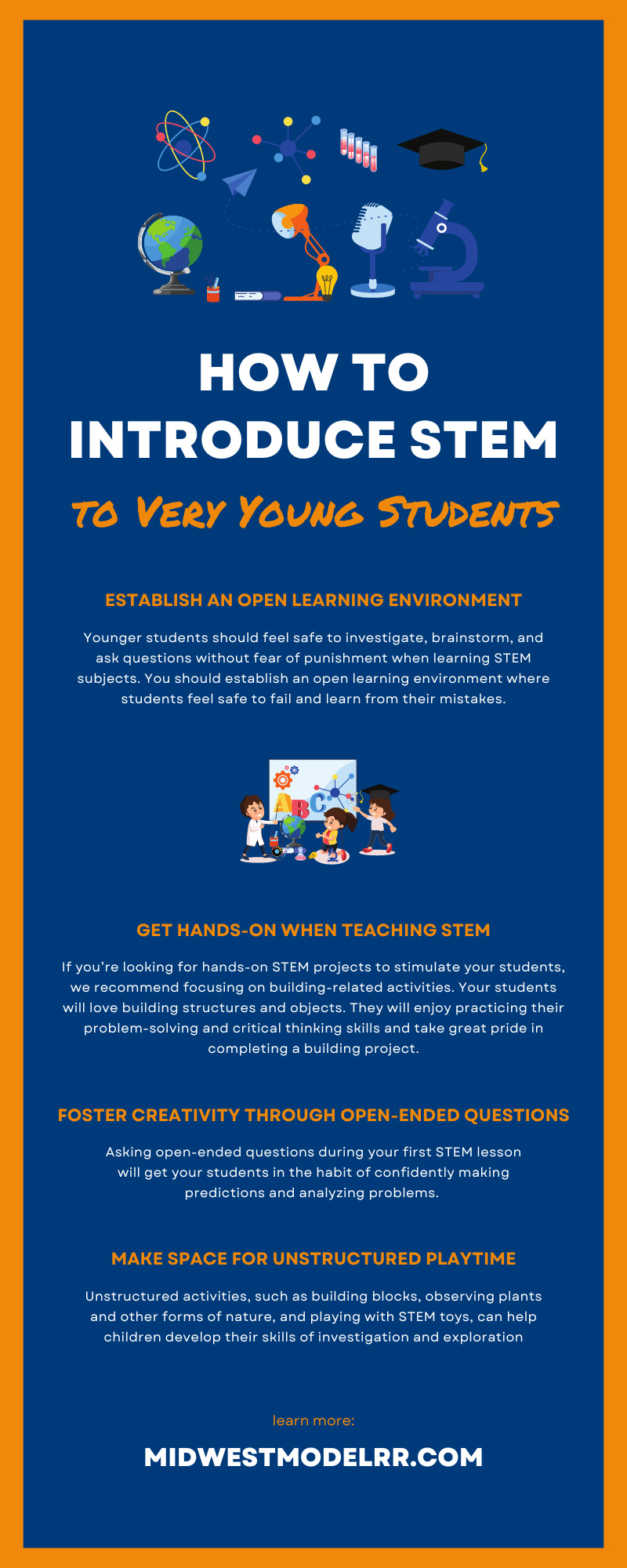When the average person hears the word STEM, they often think about fancy science and math equations that have nothing to do with their everyday life. However, science, technology, education, and math are important subjects that help young students think critically about real-world problems and find creative solutions. These skills translate into the real world and give young students a leg up as they get older.
As an educator, you must capture your students’ interests and ensure they feel excited when learning about STEM subjects. Here are our favorite methods regarding how to introduce STEM to very young students. The following tips will help you connect with your students and encourage their interest in STEM learning.
Establish an Open Learning Environment
Younger students should feel safe to investigate, brainstorm, and ask questions without fear of punishment when learning STEM subjects. You should establish an open learning environment where students feel safe to fail and learn from their mistakes. Doing this will give them the confidence to continue their STEM education as they get older.
One way to establish an open learning environment is to create a circle of trust with your students. Teachers who provide positive reinforcement and celebrate achievements can create a space where trust and STEM learning thrive.
You should also develop a culture of representation in your classroom where every student feels a sense of belonging and respect. You can create an open learning environment for students of all backgrounds and cultivate community within your classroom. STEM learning is easier when younger students feel empowered and safe enough to express themselves in the classroom.
Get Hands-On When Teaching STEM
Most younger kids absorb information when participating in practical learning experiences. Hands-on activities like building a beginner rocket kit engage multiple centers inside a student’s brain. The more brain activity you inspire, the more likely a student is to recall and apply the information during their future studies.
If you’re looking for hands-on STEM projects to stimulate your students, we recommend focusing on building-related activities. Your students will love building structures and objects. They will enjoy practicing their problem-solving and critical thinking skills and take great pride in completing a building project.
A great way to introduce STEM to very young students is to set up a building corner inside your classroom. Let your students’ imaginations run wild when working at the building corner. Encourage them to apply their daily STEM lessons during their building time and develop new and innovative ways to problem-solve. It will surprise you how quickly young children pick up STEM concepts and apply them during their building activities.
Use Word Games To Introduce STEM Vocabulary
Younger children have an incredible capacity for learning complex STEM vocabulary words. However, if you bore them to death with rote memorization or textbook reading, it may slow down the learning process. Whenever possible, you should make learning STEM vocabulary words as fun and exciting as possible.
An easy way to accomplish this is by using word games to introduce new STEM subjects and terminology. Word games are great for multiple reasons. First, they help students improve their vocabulary and spelling. Second, they help students actively recall important information. And third, they make learning new concepts and vocabulary terms fun while encouraging a growth mindset.
Don’t forget you can always increase the difficulty of your word games once students have mastered a particular concept. Your students will appreciate the extra challenge and enjoy finding new ways to apply their STEM vocabulary words and concepts. Some of our favorite word games for younger students include:
- Hangman
- Crosswords
- Word searches
- The matching game
- Word ladder
- I Spy
- Bingo
- Story prompts
Foster Creativity Through Open-Ended Questions
Another way to acquaint children with STEM learning is by asking open-ended questions. Open-ended questions signal to students that you value their input and want them to explore complex ideas using their voices. Since many STEM activities are often open-ended, you can set your students up for future success by incorporating these kinds of questions into your learning curriculum.
For example, asking questions that start with what, why, or how forces your students to think creatively and engage with the material. When introducing STEM, you want to set the tone early and create an environment where critical thinking and creative problem-solving become the norm.
Asking open-ended questions during your first STEM lesson will get your students in the habit of confidently making predictions and analyzing problems. As time passes, you will notice your students becoming more and more comfortable with thinking outside the box and answering complex questions about their course of study.
Make Space for Unstructured Playtime
In addition to creating structured learning plans, you should leave space in your STEM curriculum for unstructured playtime. Younger students, especially preschoolers and elementary students, need time to relax and apply their lessons on their own time.
Unstructured activities, such as building blocks, observing plants and other forms of nature, and playing with STEM toys, can help children develop their skills of investigation and exploration. It also encourages them to develop their interests and engage with the material in a way that suits their personality.
By leaving room for personal exploration, you increase the likelihood that students will practice STEM-related activities during their free time at home. Once they develop a personal connection and interest in STEM learning, they will continue the educational process independently in future studies. Ultimately, this is the goal of any preschool or elementary school teacher who teaches STEM learning.
Find Great Activities for STEM Learning
To tailor your STEM curriculum to younger students, you must find ways to keep their interest and make the material as engaging as possible. At AC Supply, we have many great activities for STEM learning that will encourage your students to think critically and find creative solutions to practical problems.
From model rocket kits to engineering stress blocks, we have something for every personality type. We know your students will enjoy our STEM activities and look forward to playing with our thoughtfully designed products. We encourage you to visit our website to learn more about our wholesale educational model kits for STEM learning.



